As the second half of the Bundesliga season is about to kick off, Borussia Dortmund sit six points clear at the top of the table. They should be heavy favourites for the title, right?
Well, not so fast. At the time of writing, the betting markets have Borussia Dortmund at an implied probability of around 53-58% to win the Bundesliga. The favourites, yes, but not overwhelmingly so. FiveThirtyEight’s predictions have even less faith in Dortmund, putting their chances of victory at just 33%. So what is happening? Well, it won’t surprise any long time readers of StatsBomb that it’s time to take a look at our old friend expected goals. On the defensive end, things seem mostly normal, conceding 16 non-penalty goals from an xG of 17.84. A slight overperformance, but well within the bounds of normal variance.
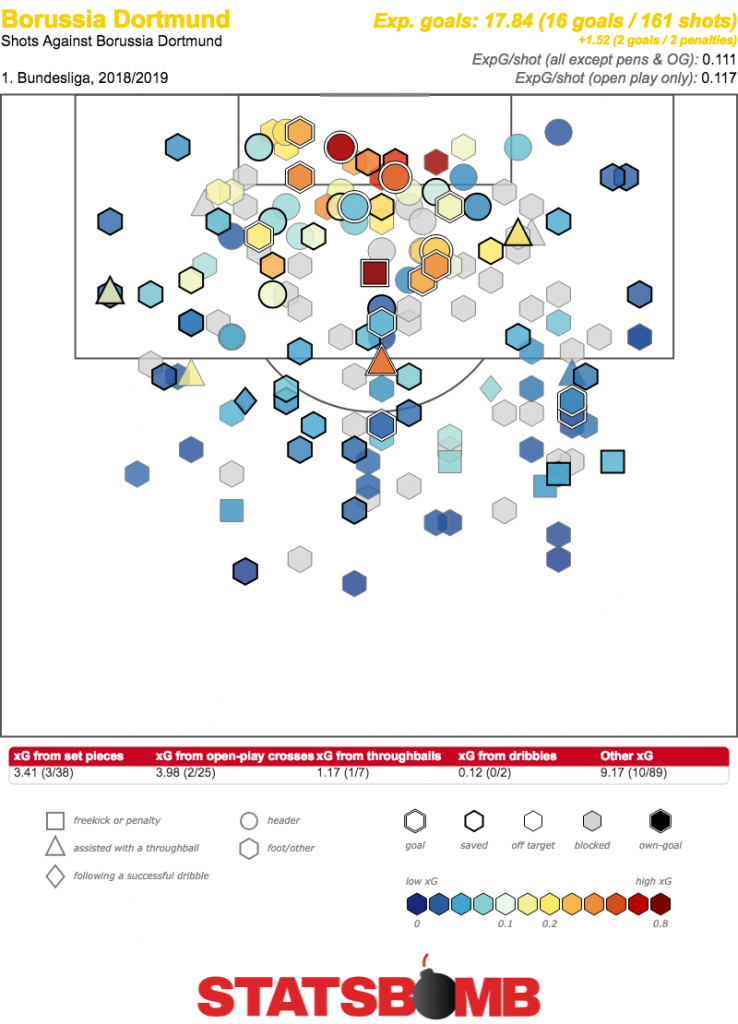
It’s on the attacking side where things start to get interesting, with 42 non-penalty goals scored from 26.3 expected. To put it another way, Borussia Dortmund have created just 0.63 expected goals for every goal scored this season.
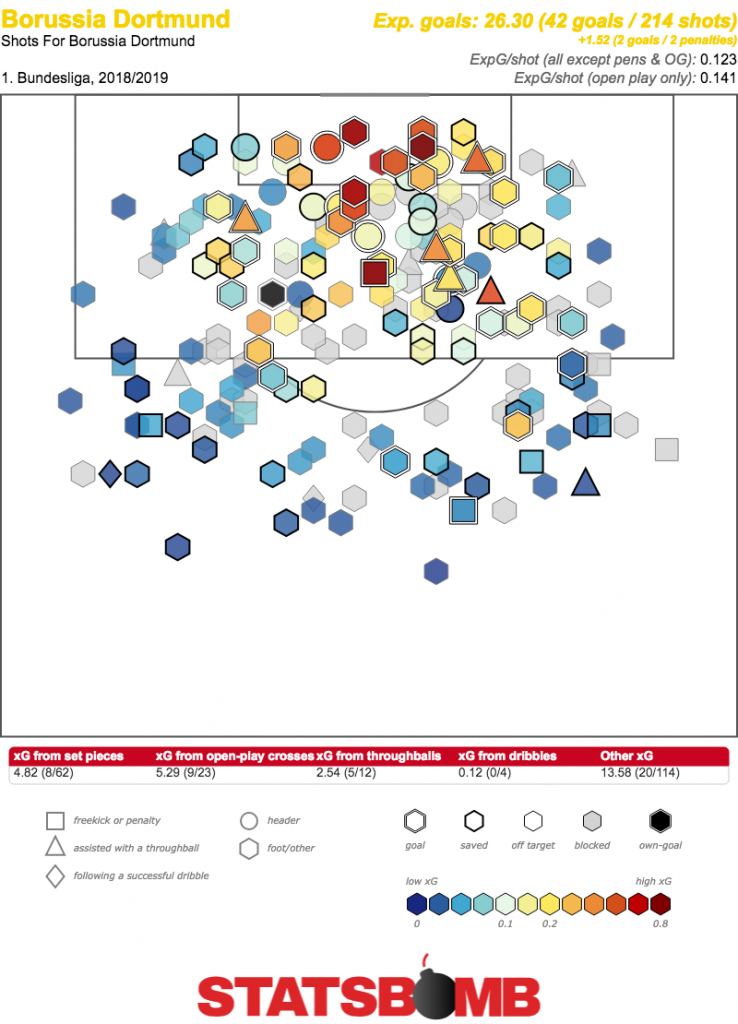
What’s the general hypothesis for this? Well, magic.
The Warlock
Ask anyone who pays close attention to expected goals and the name of Lucien Favre will receive hushed tones. StatsBomb founder Ted Knutson claimed that the Swiss coach “has a long history of high performance in the table with his teams spoofing how good xG models expect them to be. He’s done this consistently enough at Gladbach, then Nice, and now Dortmund that I believe his style of play basically exists in all the holes of naive xG models”.It doesn’t seem to matter which players he has. It doesn’t seem to matter what country he is in. It doesn’t even seem to matter how he approaches the game. Favre’s teams regularly beat xG.
The assumption of how they do it has been tactical conservatism, but aggression at the right moments. As Mike Goodman wrote here at StatsBomb back in September, “the magic of Favre is that his teams muddy up games, and press aggressively in midfield, but also manage to have cover at the back in a manner that seems to trick expected goal models”. This has certainly been the story of Favre teams in the past. His Borussia Monchengladbach side were very much in contrast to the hyper high pressing style favoured in the Bundesliga in the middle of this decade, instead looking to play more conservatively and selectively. In his time at Nice, he encountered a very different league, with French football generally being much less frantic than that on the other side of the Franco-German border. Favre responded by becoming perhaps even deeper, with the defensive activity map from his second season in the South of France showing a heavy concentration toward the team’s own goal.
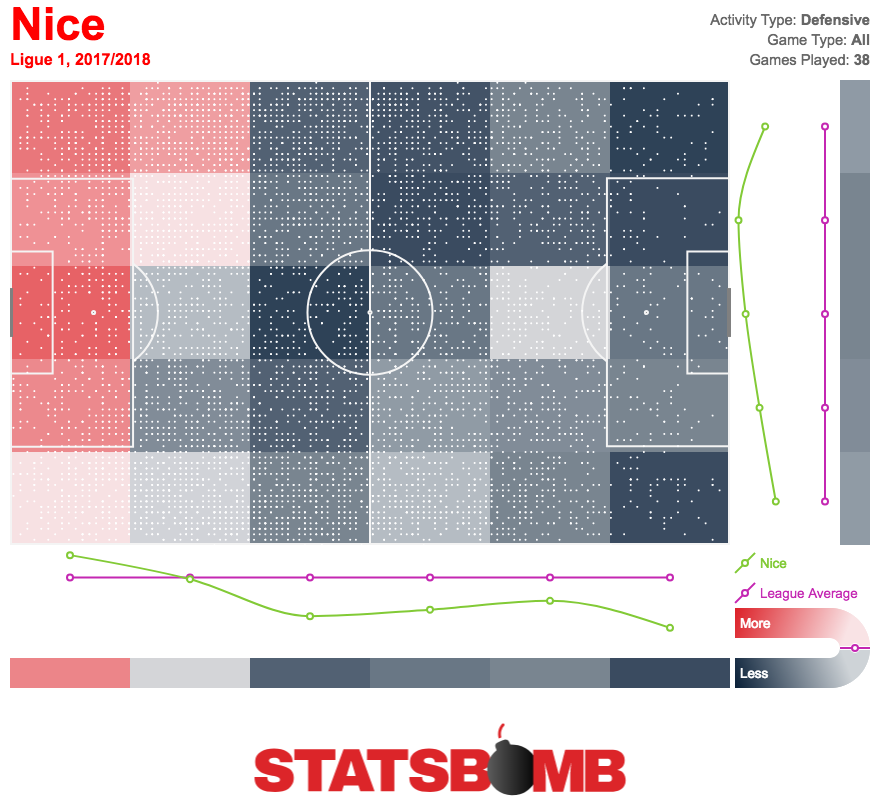
And what about Borussia Dortmund this season? Well, things couldn’t be more different.
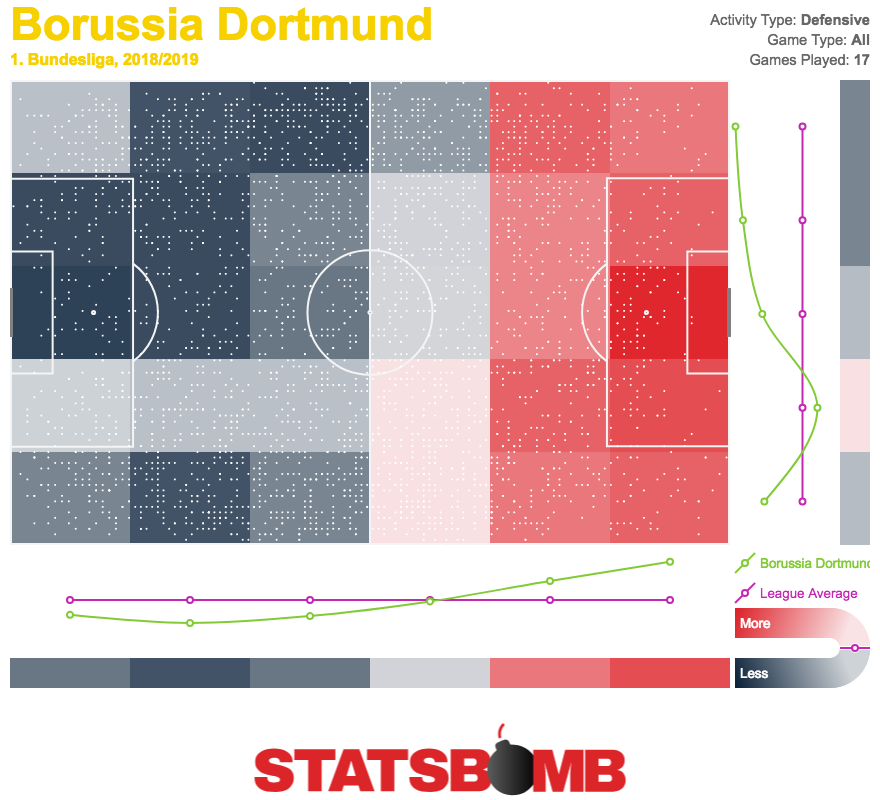
What makes things interesting is the way that Dortmund are pressing. This season, they are allowing the opposition to make an average of 12.72 passes before attempting to win the ball that’s more uncontested passes than even Favre’s Nice. What we are seeing, then, is a team that pressure the opponents heavily in their own half, but without necessarily trying to quickly win the ball back.
This makes a certain amount of sense for understanding what Dortmund are doing. Defending deep and getting bodies in the way of shots would make sense for a team that typically beat xG on the defensive side, but less so on the attacking end. As has been established, however, Dortmund’s magic is all about the attack. As for why that is remains something of an open question. The obvious answer would be that they are getting fewer opposition players than usual between the shot and the goal. StatsBomb’s model, though, includes player positions and would likely pick up at least some of this, but is actually less positive on Dortmund than more traditional xG. This does make one question whether this is sustainable or merely a positive skew in variance.
Another possible reason for this overperformance is speed. Dortmund have several players who are, to put it bluntly, really fast. Chief among the attacking players this season is old favourite Marco Reus, finally fit again and thriving in the number ten role.
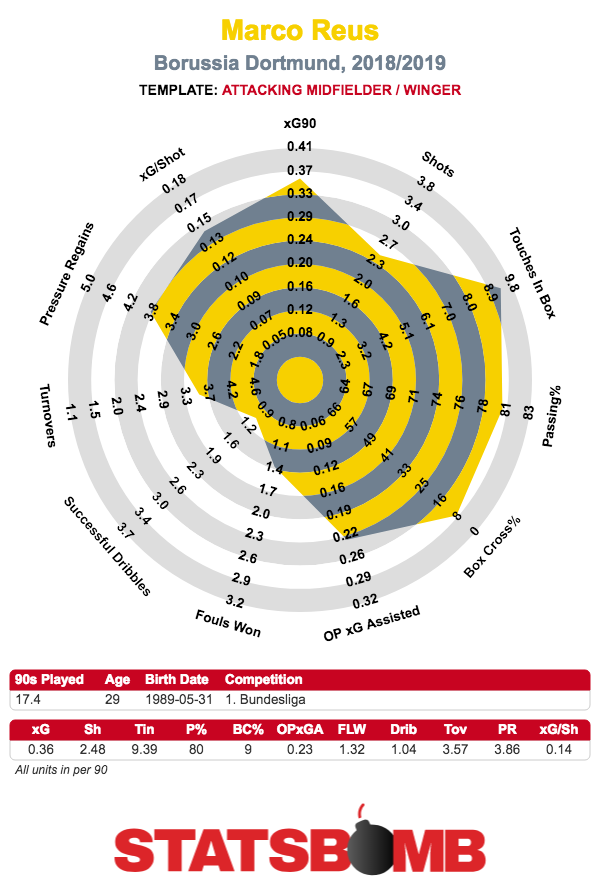
Looking at what he’s doing does give some sense of how Dortmund might be tricking the model. When watching all his goals and assists this season, he seems consistently involved in fast breaks, counter attacks, and situations where the opposing defenders look like they’ve failed to track their men due to the attackers’ rapid movement.
Reus’ partner in crime is, of course, Jadon Sancho. Only ten teenagers have managed to play at least 600 minutes in Europe’s top five leagues this season. None of the other nine have managed to get and assist half as many expected goals per 90 minutes as Sancho. The scary thing is that he’s still involved in useful ball progression on top of that. Along with his great speed being obviously useful in Dortmund’s fast breaks, his dribbling ability can help slow things down on the occasions when that is required, while his passes and cutbacks from wide areas toward central players arriving in the box remains a vital part of how the side get into such dangerous positions. Sancho is making 2.48 open play passes into the box per 90 while no other Dortmund player is getting anywhere close to that. Finding future stars is extremely difficult, and there are plenty of examples of brilliant teenagers who never achieved much, but right now there’s a strong case to be made that Sancho is the most exciting young player in football not named Kylian Mbappe.
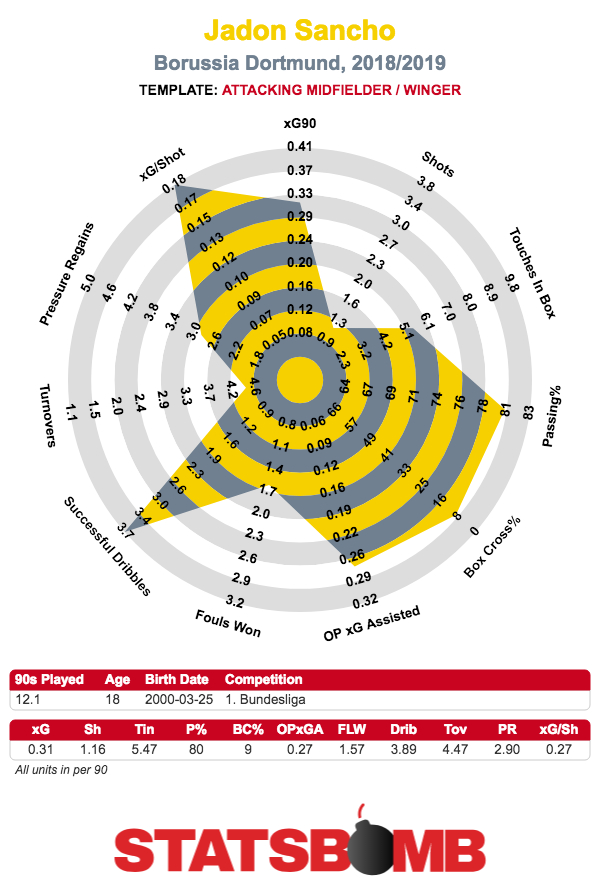
Then there is the outlandish goalscoring form of Paco Alcacer. Often coming off the bench, Alcacer has been scoring a goal every 45 minutes. The Spaniard really has been effective this season, but even a basic glance at xG shows just how unlikely he is to keep scoring at this rate.

Alcacer has scored 12 goals from 13 shots on target. Goalkeepers are going to get in the way of his chances at some point. No one is that good at kicking the ball into the goal.
As much as there might be something giving the side an extra boost, it’s hard to really be confident that they should genuinely be this far ahead of xG. Dortmund are outscoring xG from both open play and set pieces. They are ahead on both headers and shots with feet. They are ahead on chances created from crosses, created from through balls, and created from just about any other kind of pass. They are ahead on shots that were assisted and shots that were unassisted. They finish chances better than expected regardless of whether they are winning, losing or drawing. They are ahead in first halves and second halves. If there were certain types of chances, or situations, when they were specifically ahead, it would be much easier to isolate what is happening. As it is, as much as Favre’s Dortmund are playing a particular style of football, they seem to score more than expected regardless of the type of chance or situation in the game.
If there is something real happening, it likely can’t account for all of the overperformance. Dortmund could perform exactly to expectations for the second half of the season and still register as another case of Favre beating the models. The data has their expected goal difference as worse than RB Leipzig and Hoffenheim, which does seem harsh. But this may well be as close to their true level as the results.
Can Bayern Catch Up?
Everyone loves seeing a super team suffer. Bayern have been winning Bundesliga titles while barely breaking a sweat in recent years, so everyone had a good chuckle when problems started to emerge this season. But, at the risk of spoiling everyone’s fun, they look absolutely fine by the numbers, and have started to catch up to expectations after a very slow start, winning the last five games and cutting Dortmund’s lead over them to six points.
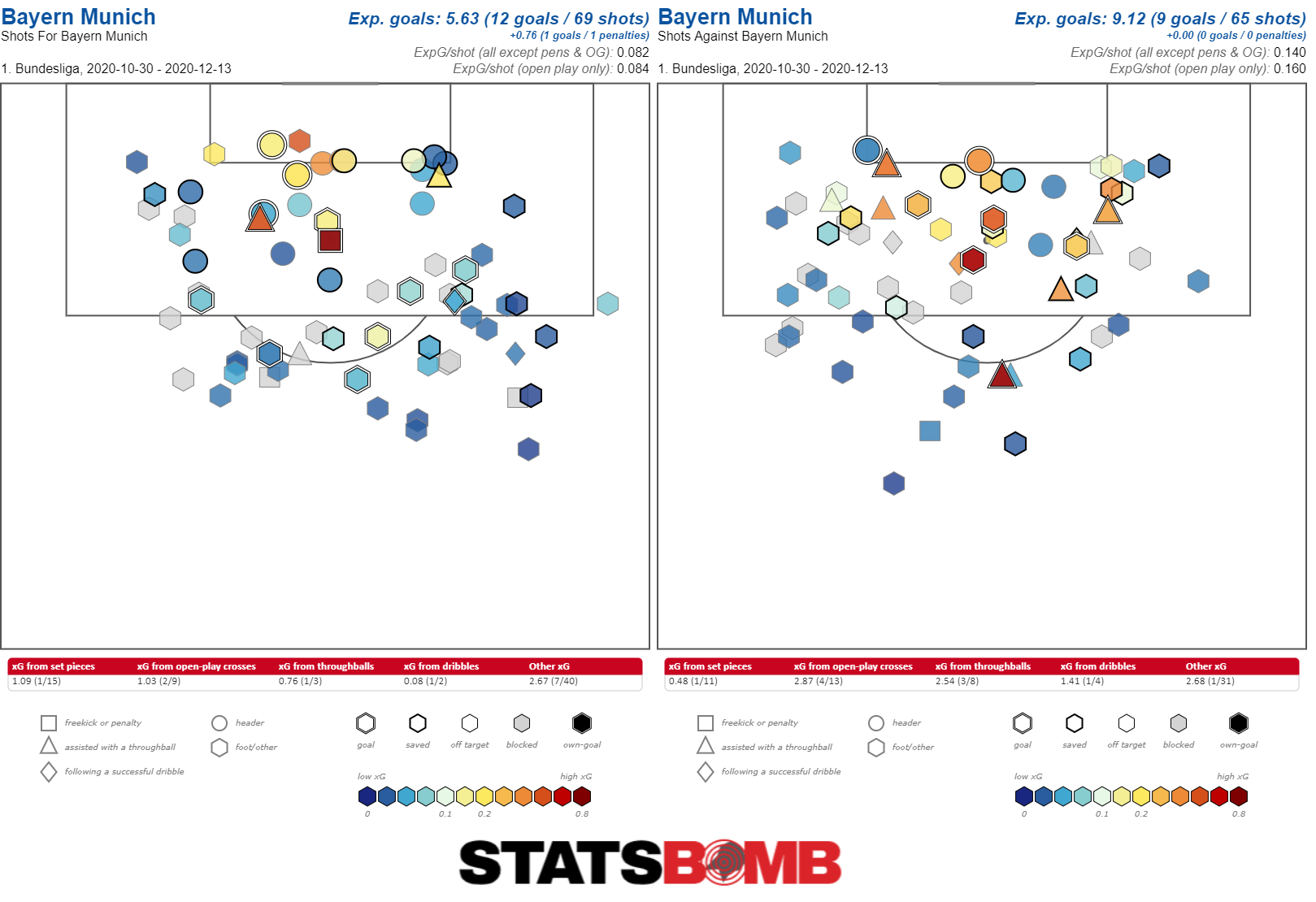
The main source of concern is Manuel Neuer. Once the belle of the world goalkeeping ball, Neuer’s shot stopping this season has been atrocious. Conceding 14 non-penalty goals from 10.10 post-shot expected goals, as well as all three of the penalties he has faced. StatsBomb currently ranks him 17th of the 18 first choice Bundesliga goalkeepers in terms of shot stopping. The obvious factor would be the injury that kept him out of almost the entirety of last season, and Bayern better hope that he’s still yet to fully recover, or simply going through an unlucky or otherwise temporary stretch of poor play, rather than permanently incapable of doing what he used to. If the latter turns out to be the case, the club will surely need to be in the market for a new number one, perhaps as early as this summer.
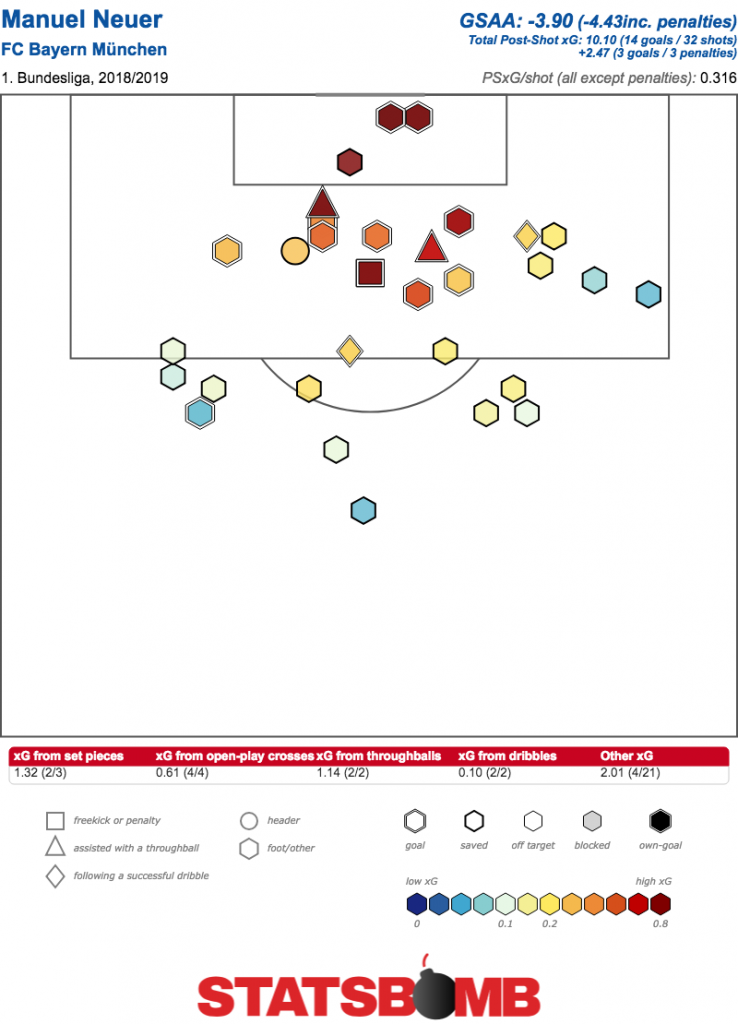
Other than that, it all generally looks okay for Bayern. The squad is getting older, but the experienced players are still mostly producing just fine. Robert Lewandowski is still getting plenty of good shots while doing more assisting work than ever. Thiago still does just about everything one could want of a midfielder. Arjen Robben is somehow still cutting inside on his left foot at 34. There is nothing broken about this team except the goalkeeper.
If the season reset to zero, Bayern would be strong favourites for the title, and deservedly so. This is a team with an expected goal difference per game of 1.29 against Dortmund’s 0.50. Bayern remain clearly the best team in the Bundesliga. The only question is whether they can be 6 points better over 17 games. If Bayern are able to cut the points gap further by the time Dortmund travel to Bavaria in early April, they could have a very good chance to overturn this. It remains very much in the balance, and the Bundesliga should be well set for a thrilling title race across the second half of the season.
Header image courtesy of the Press Association
